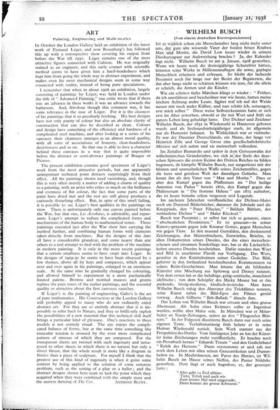ART
Painting, Engineering and Mathamatics IN October the London Gallery held an exhibition of the latest work of Fernand Leger, and now Rosenberg's has followed this up with a retrospective show covering his output from before the War till 1930. Leger remains one of the most attractive figures connected with Cubism. He was originally
trained as an engineer, and this early contact with scientific method seems to have given him a hard-headedness which kept him from going the whole way in abstract experiment, and makes even his most mechanical designs seem in some way connected with reality, instead of being pure speculations.
I remember that when in about 1926 an exhibition, largely consisting of paintings by Leger, was held in London under the title of " Advanced Painting," one critic wrote that if there was an advance in these works it was an advance towards the bathroom. And, frivolous though this comment was, it has some relevance in the case of Leger. For it is the cleanness of his paintings that is so peculiarly fetching. His best designs have not only purity of colour but also an absolute clarity of construction that can also be described as clean. Colours and design have something of the efficiency and hardness of a complicated steel machine, and after looking at a series of his canvases their cleanness emerges as an almost moral quality, with all sorts of associations of honesty, clear-headedness, decisiveness and so on. So that one is able to love a character behind these canvases in a way that is quite impossible before the abstract or semi-abstract paintings of Braque or Picasso.
The present exhibition contains good specimens of Leger's work from the most attractive periods, but one apparently unimportant technical point detracts surprisingly from their effect. All the paintings shown need varnishing, and, though this is very often merely a matter of adding a charm of quality to a painting, with an artist who relies so much on the brilliance and evenness of flat colour, the fact that some parts of the paint have dried mat and the rest are still glossy produces a curiously disturbing effect. But, in spite of this small failing, it is possible to see Leger's best qualities in the paintings on view. There is unfortunately only one canvas painted before the War, but that one, Les Acrobates, is admirable, and repre- sents Leger's attempt to reduce the complicated forms and mechanisms of the human body to mathematical terms. Three paintings executed just after the War show him carrying the method further, and combining human forms with elements taken directly from machines. But the designs of this date all have a considerable grandeur, and come nearer than any others to a real attempt to deal with the problem of the machine in modern painting. It is only in the more recent paintings that a certain smallness seems to have crept into Leger. In the designs of 1929-30 he seems to have been obsessed by a few themes, above all by keys and compasses, which appear over and over again in his paintings, enlarged to an enormous scale. At the same time he gradually changed his colouring, and allowed himself to experiment in a more puritanically limited palette. Browns and mottled mauves and greens replace the pure tones of the earlier paintings, and the essential quality so attractive about the first canvases vanishes.
If Leger's is the painting of engineering, Gabo's is the art of pure mathematics. His Constructions at the London Gallery will probably appeal to many who do not ordinarily enjoy abstract art. For they are so entirely abstract that it is im- possible to refer back to Nature, and they so brilliantly exploit the possibilities of a new material that this technical skill itself brings a particular kind of pleasure. One's reactions to these models is not entirely visual. The eye enjoys the compli- cated balance of forms, but at the same time something like muscular tension is aroused by the even more complicated pattern of stresses of which they are composed. For the transparent sheets are twisted with such ingenuity and juxta- posed to other sheets in which there is no torsion but • only a direct thrust, that the whole result is more like a diagram in Statics than a piece of sculpture. For myself I think that the greatest use of this kind of ingenuity is when it gains some content by being applied to the solution of some concrete problem, such as the setting of a play or a ballet ; and the abstract designs shown here seem to lack the point which they acquired when they were combined with the simple story and the austere dancing of The Cat. ANTHONY BLUNT.














































 Previous page
Previous page